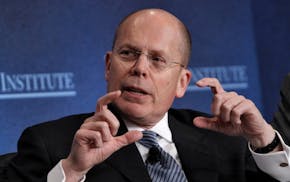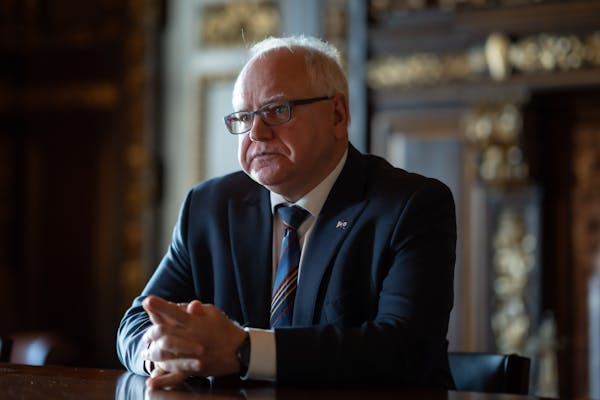Economists say the proposed merger by the Sanford and Fairview health systems could drive up health care costs by giving the consolidated medical operator more leverage when negotiating payment rates with health insurers.
Executives at Sioux Falls-based Sanford Health and Minneapolis-based Fairview Health Services announced their merger plans in November, saying that making health care more affordable — not more costly — is one of the goals. They hope to get the deal done in 2023.
Yet it's an "across the board" motivation with health system mergers for hospital operators to enhance their bargaining position, said Christopher Whaley, a health economist with RAND Corp.
Bigger health care providers typically have more power to negotiate higher prices to be paid by insurers and their members.
Sanford runs hospitals and clinics in western Minnesota and the Dakotas, while Fairview operates mostly in the Twin Cities metro area. There's growing concern that even mergers between health systems with distinct geographies can drive up prices. That's because, in cases like Fairview and Sanford, the health systems already negotiate prices with common health insurance customers.
"The literature on hospital mergers is that they result in higher prices and no change in quality," Bryan Dowd, a health economist at the University of Minnesota, said via email. "Affordability and safety are the main issues in health care today, and I don't see how the merger is going to improve either one. Hopefully, Fairview and Sanford have some plans to improve efficiency, not just increased market-pricing power, but the literature would suggest that is not the case."
The proposed merger of Sanford Health and Fairview Health Services would create a nonprofit with some 78,000 employees and more than 50 hospitals. Run from Sioux Falls under the Sanford name, the combined health system would be better positioned "to ensure high quality care for patients and communities across the Midwest for years to come," company officials said in a statement to the Star Tribune.
The chief executives at Sanford and Fairview, during an interview last month with the Star Tribune, dismissed the idea that negotiating better rates was a motivation for the merger.
"Not at all," said James Hereford, the chief executive at Fairview. "This is such a competitive market. … We have to, in fact, go the other direction and make care more affordable."
For years, the American Hospital Association has argued that mergers drive efficiencies that allow health systems to maintain services in communities while improving the quality of care. The trade group in 2019 touted an updated study suggesting that insurers and patients do see savings from efficiency with mergers.
But that study has "large flaws," said Whaley of RAND Corp., and isn't consistent with the findings from a large body of peer-reviewed and independent analyses.
If Sanford and Fairview merge, the larger health system will likely get more efficient in how it operates, he said. But it will have less incentive to pass those savings to customers because there's less competition. Studies have shown that with mergers patients and insurers generally pay more, he said.
"Negotiating better rates with insurers is a consideration and a motivation for consolidation — I think that's true across the board," Whaley said. "But when these hospitals are facing scrutiny by regulators, they're going to say: 'Look, the reason we're consolidating and merging is not to get better rates, it's actually to provide better access to care for our patients and to keep the rural hospital system afloat.' "
The broad trend over the decades has been ever-increasing costs as health care providers consolidate, said Brooks Deibele, enterprise sales leader in Minneapolis for Holmes Murphy, a benefits consulting firm.
The Sanford-Fairview merger brings the chance for more efficiency and innovation, Deibele said, but he believes it's motivated at least in part by a desire to gain leverage with health insurers. The deal wouldn't reduce competition in the Twin Cities metro area, he said, but it would link Fairview to Sanford's bargaining power in smaller communities.
Currently, Sanford has 19 hospitals and 70 clinic locations in greater Minnesota.
"You're hard-pressed to find any evidence that merger-and-acquisition activity in the health care provider space has led to lower costs," he said.
Even so, employers offering worker health plans are on the fence about the merger proposal, Deibele said. On one hand, there's the risk of higher prices. On the other, some of that could be mitigated if Sanford brought its health plan to the Twin Cities, boosting health insurance competition. It's not clear, however, if Sanford plans to do so.
He believes another key motivation for the merger is helping Fairview address financial challenges, including labor costs that are poised to go higher amid an ongoing labor dispute with nurses.
Fairview is closing in on a fourth consecutive year of annual operating losses in excess of $90 million. Back in 2013 when the health systems failed to complete a merger proposal, Fairview was reporting operating profits, according to a Star Tribune review of financial data.
Right now, most major health systems are facing financial troubles with rising labor costs following revenue hits from COVID-related delays in elective procedures, said Lawton Burns, a professor of health care management at the Wharton School at the University of Pennsylvania.
Health system CEOs aren't sure what to do about all the red ink, Burns said. Belt-tightening is hard work, so some executives are turning to mergers in hopes of growing their way out of troubles, he said. Yet their announcements — including the one from Sanford and Fairview — are short on details that explain exactly how the combination will help.
"They haven't articulated any case at all — but to be honest, nobody does," Burns said. "A lot of major hospital systems that we're all familiar with are kind of sucking wind right now. … These mergers, I just don't see how that helps anybody except with a few exceptions."

UnitedHealth sues the Guardian, alleging defamation in coverage of nursing home care

Prices for international flights drop as major airlines navigate choppy economic climate
Minnesota's med spa industry rises in popularity — and with little regulation

Hundreds line up at Best Buy to nab Nintendo Switch 2, in scene like '90s opening parties

